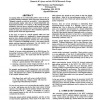Free Online Productivity Tools
i2Speak
i2Symbol
i2OCR
iTex2Img
iWeb2Print
iWeb2Shot
i2Type
iPdf2Split
iPdf2Merge
i2Bopomofo
i2Arabic
i2Style
i2Image
i2PDF
iLatex2Rtf
Sci2ools
113
Voted
NAACL
1994
1994
Pattern Matching in a Linguistically-Motivated Text Understanding System
An ongoing debate in text understanding efforts centers on the use of pattern-matching techniques, which some have characterized as "designed to ignore as much text as possible," versus approaches which primarily employ rules that are domain-independent and linguisticaUy-motivated. For instance, in the message-processing community, there has been a noticeable pulling back from largecoverage grammars to the point where, in some systems, traditional models of syntax and semantics have been completely replaced by domain-specific finite-state approximations. In this paper we report on a hybrid approach which uses such domain-specific patterns as a supplement to domain-independent grammar rules, domain-independent semantic rules, and automatically hypothesized domain-specific semantic rules. The surprising result, as measured on TIPSTER test data, is that domain-specific pattern matching improved performance, but only slightly, over more general linguistically-motivatedtechniques...
Domain-specific Finite-state Approximations | Domain-specific Pattern | Domain-specific Semantic Rules | NAACL 1994 | NAACL 2007 |
Related Content
| Added | 02 Nov 2010 |
| Updated | 02 Nov 2010 |
| Type | Conference |
| Year | 1994 |
| Where | NAACL |
| Authors | Damaris M. Ayuso |
Comments (0)

